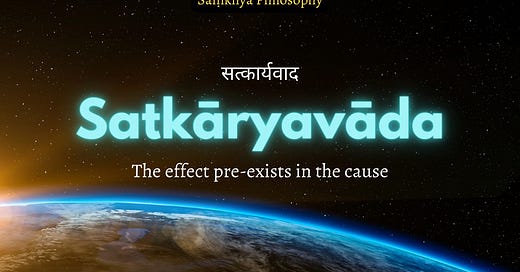A morning headache will inevitably bring back the memories of last night. So, unless there’s alcohol to blame, you’ll reach out for your phone to understand the causal relationship between activity and pain — “Morning headache causes and treatments”.
However, a Google search will likely lead you to all kinds of ailments known to the human mind. Wisdom lies in not googling your symptoms. And yet, we Google to fulfil the desperate need to know the cause.
Our innate nature of understanding causal connections fuelled the scientific age and made us the species that has ventured beyond the planet. From Aristotle’s Four Causes to Judea Pearl’s theory of causal inference, causation has captured our attention for centuries.
According to our general understanding of causality, the cause precedes the effect — “If X is a necessary cause of Y, then the presence of Y necessarily implies the prior occurrence of X” (Necessary causes)1
However, Sāṃkhya’s philosophy offers a radical theory of causation that’s fundamental to its philosophical system.
Satkāryavāda
According to Sāṃkhya, the effect pre-exists in the cause. Something cannot come out of nothing. Hence, the effect is implicit in the cause. This theory is known as Satkaryavāda. It’s described in shloka 9 of Isvarakrsna's Sāṃkhyakarīkā:
असदकरणादुपादानग्रहणात् सर्वसम्भवाभावात् ।
शक्तस्य शक्यकरणात् कारणभावाच्च सत्कार्यम् ॥ ९ ॥
The effect is immediately known as what was implicit in the cause. The cause in fact is manifest in the effect as its very self, the effect immediately showing it. The effect reveals the cause as having become it, as still becoming it and so far as it is itself manifest, as including the manifest effect within it.” - K.C Bhattacharya, Studies in Philosophy
The term “Satkārya” means “existent effect”. The effect is not a new event or condition but simply a modification of that which is already present in the cause. Sāṃkhya philosophers often explain Satkāryavāda with the simile of milk and curd. Curd is nothing but a transformation or manifestation of the milk. It is already potentially present in the milk.
But why would Sāṃkhya propose a non-intuitive theory of causation?
Satkāryavāda plays a crucial role in developing Sankhya’s evolutionary theory. In our previous issue, creation of the cosmos, we understood that the dualism of Puruṣa and Prakṛti is fundamental to Sāṃkhya philosophy. Both are abstract metaphysical concepts. Puruṣa is pure consciousness which is neither created nor creative. Prakṛti gives rise to everything in the universe when it transforms from unmanifested (Avyakta (अव्यक्त)) to manifested form (Vyakta (व्यक्त)).
The unmanifested form of Prakṛti, also known as (Mūla-Prakṛti)(मूलप्रकृति), consists of three guṇas - Sattva, Rajas, and Tamas. In our last article, we learned that these guṇas have psychical qualities — Sattva is associated with goodness, illumination, and thought. Rajas with passion, stimulation, and movement. And Tamas with darkness, slowness, and heaviness.
The three guṇas are in equilibrium in unmanifested Prakṛti. But the presence of Puruṣa disturbs the equilibrium, and the guṇas combine in different forms to create the cosmos in the manifest form of Prakṛti. Taking Satkāryavāda as the fundamental principle, we understand that all the world was contained in the form of guṇas inside Mūla-Prakṛti. The creation of the cosmos is nothing but a transformation of the guṇas in core elements that define our world — The effect pre-existed in the cause.
A bit of life philosophy
The human genome is known to play a role in personality development. But we know that external influences/environment also shape us as an individual. Some personality traits pre-exist in us while others develop throughout our life. By understanding our nature through self-reflection, we can nurture ourselves to react better in unfavourable situations. Maybe applying the Sattva Operator can change what pre-exists and make us better individuals. While Satkāryavāda might not give you a ticket to a physics conference, it does nudge you to deliberate on what pre-exists and what might exist.
“We can't know the world if we don't know ourselves.” - The Socrates Express.





Love your work Adit, do you write anywhere else?